Time space and single-cell resolved tissue lineage trajectories and laterality of body plan at gastrulation
- PMID: 37709743
- PMCID: PMC10502153
- DOI: 10.1038/s41467-023-41482-5
Time space and single-cell resolved tissue lineage trajectories and laterality of body plan at gastrulation
Abstract
Understanding of the molecular drivers of lineage diversification and tissue patterning during primary germ layer development requires in-depth knowledge of the dynamic molecular trajectories of cell lineages across a series of developmental stages of gastrulation. Through computational modeling, we constructed at single-cell resolution, a spatio-temporal transcriptome of cell populations in the germ-layers of gastrula-stage mouse embryos. This molecular atlas enables the inference of molecular network activity underpinning the specification and differentiation of the germ-layer tissue lineages. Heterogeneity analysis of cellular composition at defined positions in the epiblast revealed progressive diversification of cell types. The single-cell transcriptome revealed an enhanced BMP signaling activity in the right-side mesoderm of late-gastrulation embryo. Perturbation of asymmetric BMP signaling activity at late gastrulation led to randomization of left-right molecular asymmetry in the lateral mesoderm of early-somite-stage embryo. These findings indicate the asymmetric BMP activity during gastrulation may be critical for the symmetry breaking process.
© 2023. Springer Nature Limited.
Conflict of interest statement
The authors declare no competing interests.
Figures
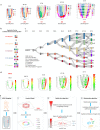
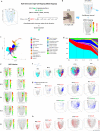
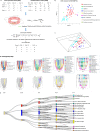
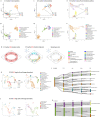
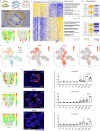
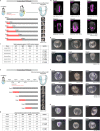

Similar articles
-
Mouse gastrulation: Coordination of tissue patterning, specification and diversification of cell fate.Mech Dev. 2020 Sep;163:103617. doi: 10.1016/j.mod.2020.103617. Epub 2020 May 27. Mech Dev. 2020. PMID: 32473204 Free PMC article. Review.
-
Mouse gastrulation: Attributes of transcription factor regulatory network for epiblast patterning.Dev Growth Differ. 2018 Oct;60(8):463-472. doi: 10.1111/dgd.12568. Dev Growth Differ. 2018. PMID: 30368783
-
Molecular architecture of lineage allocation and tissue organization in early mouse embryo.Nature. 2019 Aug;572(7770):528-532. doi: 10.1038/s41586-019-1469-8. Epub 2019 Aug 7. Nature. 2019. PMID: 31391582
-
Zebrafish gastrulation: Putting fate in motion.Curr Top Dev Biol. 2020;136:343-375. doi: 10.1016/bs.ctdb.2019.10.009. Epub 2019 Dec 27. Curr Top Dev Biol. 2020. PMID: 31959295 Review.
-
Dissecting the dynamics of signaling events in the BMP, WNT, and NODAL cascade during self-organized fate patterning in human gastruloids.PLoS Biol. 2019 Oct 15;17(10):e3000498. doi: 10.1371/journal.pbio.3000498. eCollection 2019 Oct. PLoS Biol. 2019. PMID: 31613879 Free PMC article.
Cited by
-
High-resolution mapping of single cells in spatial context.Nat Commun. 2025 Jul 15;16(1):6533. doi: 10.1038/s41467-025-61667-4. Nat Commun. 2025. PMID: 40664667 Free PMC article.
-
Integration of single-cell and spatial transcriptomics by SEU-TCA reveals the spatial origin of early cardiac progenitors.Genome Biol. 2025 Jun 10;26(1):158. doi: 10.1186/s13059-025-03633-3. Genome Biol. 2025. PMID: 40495257 Free PMC article.
-
A message passing framework for precise cell state identification with scClassify2.Genome Biol. 2025 Aug 19;26(1):252. doi: 10.1186/s13059-025-03722-3. Genome Biol. 2025. PMID: 40830895 Free PMC article.
-
Multi-omics in exploring the pathophysiology of diabetic retinopathy.Front Cell Dev Biol. 2024 Dec 11;12:1500474. doi: 10.3389/fcell.2024.1500474. eCollection 2024. Front Cell Dev Biol. 2024. PMID: 39723239 Free PMC article. Review.
-
The molecular and cellular choreography of early mammalian lung development.Med Rev (2021). 2024 Mar 26;4(3):192-206. doi: 10.1515/mr-2023-0064. eCollection 2024 Jun. Med Rev (2021). 2024. PMID: 38919401 Free PMC article. Review.
References
-
- Lawson KA, Meneses JJ, Pedersen RA. Clonal analysis of epiblast fate during germ layer formation in the mouse embryo. Development. 1991;113:891–911. - PubMed
-
- Tam PP. Regionalisation of the mouse embryonic ectoderm: allocation of prospective ectodermal tissues during gastrulation. Development. 1989;107:55–67. - PubMed
-
- Quinlan GA, Williams EA, Tan SS, Tam PP. Neuroectodermal fate of epiblast cells in the distal region of the mouse egg cylinder: implication for body plan organization during early embryogenesis. Development. 1995;121:87–98. - PubMed
-
- Tam PP, Beddington RS. The formation of mesodermal tissues in the mouse embryo during gastrulation and early organogenesis. Development. 1987;99:109–126. - PubMed
Publication types
MeSH terms
LinkOut - more resources
Full Text Sources
Molecular Biology Databases

